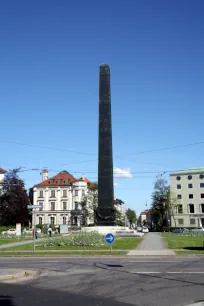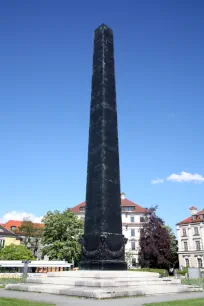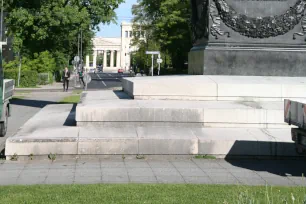When it was first constructed, this unique “Square” was a lesson in neoclassical uniformity. The square’s centerpiece is a tall black obelisk.


Not Really a Square
Karolinenplatz is a square created between 1809 and 1812 on the route from the Residenz Palace to the Nymphenburg Palace. It was at the center of a district known as Maxvorstadt, named after Maximilian I who instigated the development of the area.
The square was designed by Karl von Fischer, a renowned German architect who also designed Munich’s National Theatre. It is believed that Fischer modeled the star-shaped Karolinenplatz after the Place de l’Étoile in Paris (the site of the Arc de Triomphe).
The Monument
The most notable feature of the Karolinenplatz is the tall monument which sits in its center. This obelisk was designed by Leo von Klenze, court architect to King Ludwig I. The architect was known for his love of Greek Revival design and also created the Propyläen and the Ruhmeshalle in Munich.
The obelisk was erected in 1833 and honors the more than thirty thousand Bavarian soldiers who gave their lives in Napoleon’s 1812 campaign against Russia. Designed by Leo von Klenze, it stands 29 meters (95 feet) high and consists of a number of metal plates made from melted down weapons captured from the Turkish army during the Battle of Navarino.
Notable Nearby Buildings

Most architecture buffs will tell you that the homes at the rear of the square are of particular note, as they were designed to fit the star shape of the Karolinenplatz. The building number five, which once housed the Bruckmann family, home to a wealthy printer who introduced Adolf Hitler to the industrialists and bankers who provided substantial financial support for the dictator and his Nazi regime.
The most notorious building in the neighborhood was the ‘Braunes Haus’ (Brown House) on the Brienner Straße. This building, the former Barlow Palace, became the headquarters of the NSDAP’s Reichsleitung in 1930, the first of what would become a government quarter of the Nazi regime. The building was destroyed by an allied air bombing during World War II.
- Next: Kunstareal
- More Sights & Attractions in Munich

